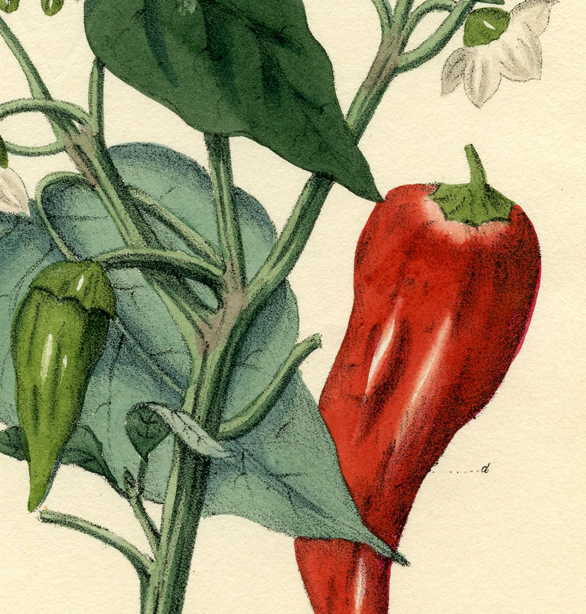In her popular book Mistress of Spices, Chitra Divakaruni wrote, “Chili, spice of red Thursday, which is the day of reckoning. Day which invites us to pick up the sack of our existence and shake it inside out.” Divakaruni’s description of chili peppers is metaphorical and creative, but the healing-heating-circulation boosting ability of the spice to “pick up our existence and shake it inside out” is real and research backed.
Think Fresno, Habanero, Serrano or Jalapeno and the adjectives that instantly come up are feisty, fiery, spicy or zesty. Add to them, Cayenne, Anaheim, Thai, Guntur sannam and Kashmiri mirchi, you have steered yourself into a super (hot) destination. The kind of destination where pain disappears and endorphins appear, cancer cells are crushed and the skin is flushed, circulation is boosted and the common cold, busted.
It is said that Christopher Columbus accidently stumbled upon the chili pepper plant in one of the New World islands and found that the fiery looking red fruit tasted a little bit like black pepper and dubbed it, red pepper. Through his travels, the red pepper fieriness spread far and wide, reaching, India, China and Thailand and the rest of the world. Chili peppers, native to South America, have long (they have an 8000 year old history) been associated with several health benefits. Historical accounts, according to the Smithsonian Institute report that ancient Mayans used them to treat infected wounds, earaches and digestive problems.
Capsaicin, the Compound Responsible for Chili Pepper”s Healing Fame
Capsaisin, the compound in chilis that gives them their fieriness is also the one that is responsible for its healing medicinal properties. The compound is a well-known topical pain reducer. Walk into any drugstore and you will find several topical capsaicin creams, claiming to relieve pain caused by diabetic neuropathy, arthritis, cluster headaches, psoriasis, mouth sores, etc. As a therapeutic ingredient, it works by initially stimulating and then reducing pain signals in the body. In a painful condition called postherpetic neuralgia (PHN) that affects the nerve fibers and skin, a 0.075 percent capsaicin cream brought significant relief to patients suffering from this hard to manage condition. Taken internally, capsaicin is a powerful inflammation fighter. It inhibits a neuropeptide called substance P that is associated with several inflammatory processes.
In addition, capsaicin works as an ulcer preventer, heart healer and mucus reducer. Contrary to the belief that chili peppers exacerbate ulcers, some research studies show that they can actually protect the stomach lining. A 1995 study from Singapore showed that eating chili peppers everyday reduced the risk of developing peptic ulcers by a whopping 53 percent. Other studies have shown the role of chili peppers in boosting cardiovascular health by reducing the risks of heart attacks, strokes and pulmonary online casino embolisms. And while there are several studies to support the mucus reducing properties of chili peppers, most of us have experienced its sinus clearing, mucus thinning properties firsthand.
Aches, pains, mucus and digestion aside, research shows that the compound is cancer preventive. In an October 2014 study funded by the American Institute of Cancer Research, researchers found that capsaicin kills lung cancer cells and slows the growth of tumor in mice. An earlier study published in the March 2006 journal Cancer Research showed that capsaicin stopped prostate cancer cells from spreading.
As if all these accolades were not substantial enough, a new study reports that eating chili peppers regularly prevents weight gain from a high fat diet. The University of Wyoming study presented at Biophysical Society’s Annual Meeting found that mice were fed a diet that had capsaicin in it, even though it was only a miniscule 0.01 percent of the diet, did not gain weight even when they were on a fat laden diet. The researchers believed that the weight prevention abilities of capsaicin are due to its ability to turn unhealthy white fat into fat busting brown fat through the process of thermogenics. Co-author of the study, Vivek Krishnan said “In our bodies, white fat cells store energy and brown fat cells serve as thermogenic machinery to burn stored fat.” Capsaisin had similar weight maintanance benefits as exercise, during which brown fat converts white fat into more brown fat.
What is left to Say
Ready to shake your existence inside out and look svelte? Include chili peppers in your diet; eat them, but not too many. Remember that capsaicin only made up 0.01 percent in the mice weight loss study. Less is more when it comes to the spice. A Jalapeno (or Kashmiri mirchi) a day, will keep the doctor away.
Sources:
- Goodreads; Chitra Banerjee Divakaruni
- Ratna Rajaiah; How the Banana Went to Heaven
- Smithsonian; What”s so Hot about Chili Peppers
- Journal of Pain & Palliative Care Pharmacotherapy; Capsaicin
- Gut; Effect of Capsaicin and Chilli on Ethanol induced Gastric Mucosal Injury in the Rat.
- British Journal of Nutrition; Effects of Daily ingestion of Chilli on Serum Lipoprotein Oxidation in Adult Men and Women.
- The World’s Healthiest Foods; Chili Peppers, Dried
- Cancer Research; Capsaicin, a Component of Red Peppers, Inhibits the Growth of Androgen-Independent, p53 Mutant Prostate Cancer Cells.
- American Institute of Cancer Research; Compound in Chili Pepper Slows Lung Cancer Tumor Growth in Animal Study
- Medical Daily; Chili Peppers May Solve Obesity Epidemic; Spice Up Your Weight Loss With These 3 Recipes
- Image Credit; Graphics Fairy
